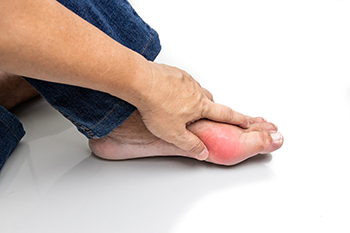Fungal toenail infections are a common occurrence, particularly in people over the age of 70. This type of infection, medically referred to as onychomycosis, can embed itself within the multiple layers that make toenails as well as their underlying nail beds. This is one of the reasons why killing the fungus that causes the infection can be so difficult. Another reason is that the fungal organism is highly contagious and can live for months in the warm, moist environments it thrives in (locker rooms, communal showers, bathrooms, enclosed shoes, swimming areas, etc.). It can be transmitted easily onto bare feet, or by wearing wet socks or shoes, and from direct contact with someone who is infected. Nails that are infected by a fungal organism can become thickened, brittle, crumbly, discolored, deformed, and even painful. Depending on the severity of the infection, a podiatrist can use various methods of treatment to eradicate the fungus, prevent it from returning, and help the natural nail to regrow.
If left untreated, toenail fungus may spread to other toenails, skin, or even fingernails. If you suspect you have toenail fungus it is important to seek treatment right away. For more information about treatment, contact Serjik Nazarian, DPM of Sedona Foot & Ankle Specialists. Our doctor can provide the care you need to keep you pain-free and on your feet.
Symptoms
- Warped or oddly shaped nails
- Yellowish nails
- Loose/separated nail
- Buildup of bits and pieces of nail fragments under the nail
- Brittle, broken, thickened nail
Treatment
If self-care strategies and over-the-counter medications does not help your fungus, your podiatrist may give you a prescription drug instead. Even if you find relief from your toenail fungus symptoms, you may experience a repeat infection in the future.
Prevention
In order to prevent getting toenail fungus in the future, you should always make sure to wash your feet with soap and water. After washing, it is important to dry your feet thoroughly especially in between the toes. When trimming your toenails, be sure to trim straight across instead of in a rounded shape. It is crucial not to cover up discolored nails with nail polish because that will prevent your nail from being able to “breathe”.
In some cases, surgical procedure may be needed to remove the toenail fungus. Consult with your podiatrist about the best treatment options for your case of toenail fungus.
If you have any questions, please feel free to contact our offices located in Cottonwood and Prescott, AZ . We offer the newest diagnostic and treatment technologies for all your foot care needs.
Read more about Treating Toenail Fungus
 Gout is known to be an excruciating, painful foot condition. It often affects the big toe, and can cause difficulty in walking. It develops as a result of a uric acid build-up in the joints of the big toe. This can happen as a result of genetic traits, or it may come from specific types of foods and drinks that are consumed in abundance such as red meat, shellfish, sugary drinks and alcohol. Symptoms can consist of swollen joints, tenderness, and the affected area may be red. In order to make a proper diagnosis, a podiatrist may extract a portion of fluid between the affected joints and view it under a microscope. This is an accurate method for observing urate crystals. Research has indicated it may be beneficial to drink cherry juice or skim milk, as this may provide mild relief. If you have any symptoms of gout, it is strongly suggested that you consult with a podiatrist as quickly as possible who can properly diagnose and treat this painful foot ailment.
Gout is known to be an excruciating, painful foot condition. It often affects the big toe, and can cause difficulty in walking. It develops as a result of a uric acid build-up in the joints of the big toe. This can happen as a result of genetic traits, or it may come from specific types of foods and drinks that are consumed in abundance such as red meat, shellfish, sugary drinks and alcohol. Symptoms can consist of swollen joints, tenderness, and the affected area may be red. In order to make a proper diagnosis, a podiatrist may extract a portion of fluid between the affected joints and view it under a microscope. This is an accurate method for observing urate crystals. Research has indicated it may be beneficial to drink cherry juice or skim milk, as this may provide mild relief. If you have any symptoms of gout, it is strongly suggested that you consult with a podiatrist as quickly as possible who can properly diagnose and treat this painful foot ailment.
Gout is a painful condition that can be treated. If you are seeking treatment, contact Serjik Nazarian, DPM from Sedona Foot & Ankle Specialists. Our doctor will treat your foot and ankle needs.
What Is Gout?
Gout is a form of arthritis that is characterized by sudden, severe attacks of pain, redness, and tenderness in the joints. The condition usually affects the joint at the base of the big toe. A gout attack can occur at any random time, such as the middle of the night while you are asleep.
Symptoms
- Intense Joint Pain - Usually around the large joint of your big toe, and it most severe within the first four to twelve hours
- Lingering Discomfort - Joint discomfort may last from a few days to a few weeks
- Inflammation and Redness -Affected joints may become swollen, tender, warm and red
- Limited Range of Motion - May experience a decrease in joint mobility
Risk Factors
- Genetics - If family members have gout, you’re more likely to have it
- Medications - Diuretic medications can raise uric acid levels
- Gender/Age - Gout is more common in men until the age of 60. It is believed that estrogen protects women until that point
- Diet - Eating red meat and shellfish increases your risk
- Alcohol - Having more than two alcoholic drinks per day increases your risk
- Obesity - Obese people are at a higher risk for gout
Prior to visiting your podiatrist to receive treatment for gout, there are a few things you should do beforehand. If you have gout you should write down your symptoms--including when they started and how often you experience them, important medical information you may have, and any questions you may have. Writing down these three things will help your podiatrist in assessing your specific situation so that he or she may provide the best route of treatment for you.
If you have any questions, please feel free to contact our offices located in Cottonwood and Prescott, AZ . We offer the newest diagnostic and treatment technologies for all your foot care needs.
Read more about Gout There are many people who experience itchy feet at night. They typically do not have foot issues during the day but may find their feet to be itchy when trying to go to sleep. There are several reasons why this may happen. The condition known as Athlete’s foot may contribute to itchiness at night. Additionally, dry skin may play a significant role and may be remedied by using a good moisturizer. Research has indicated that nerve damage caused by diabetes or liver disease may result in itchy feet at night. It may help to manage ongoing stressful conditions, which may even provide mild relief. If you endure itchy feet at night, or know someone who does, please schedule an appointment with a podiatrist who can determine the cause and provide various treatment options.
There are many people who experience itchy feet at night. They typically do not have foot issues during the day but may find their feet to be itchy when trying to go to sleep. There are several reasons why this may happen. The condition known as Athlete’s foot may contribute to itchiness at night. Additionally, dry skin may play a significant role and may be remedied by using a good moisturizer. Research has indicated that nerve damage caused by diabetes or liver disease may result in itchy feet at night. It may help to manage ongoing stressful conditions, which may even provide mild relief. If you endure itchy feet at night, or know someone who does, please schedule an appointment with a podiatrist who can determine the cause and provide various treatment options.
Foot Pain
Foot pain can be extremely painful and debilitating. If you have a foot pain, consult with Serjik Nazarian, DPM from Sedona Foot & Ankle Specialists. Our doctor will assess your condition and provide you with quality foot and ankle treatment.
Causes
Foot pain is a very broad condition that could be caused by one or more ailments. The most common include:
- Bunions
- Hammertoes
- Plantar Fasciitis
- Bone Spurs
- Corns
- Tarsal Tunnel Syndrome
- Ingrown Toenails
- Arthritis (such as Gout, Rheumatoid, and Osteoarthritis)
- Flat Feet
- Injury (from stress fractures, broken toe, foot, ankle, Achilles tendon ruptures, and sprains)
- And more
Diagnosis
To figure out the cause of foot pain, podiatrists utilize several different methods. This can range from simple visual inspections and sensation tests to X-rays and MRI scans. Prior medical history, family medical history, and any recent physical traumatic events will all be taken into consideration for a proper diagnosis.
Treatment
Treatment depends upon the cause of the foot pain. Whether it is resting, staying off the foot, or having surgery; podiatrists have a number of treatment options available for foot pain.
If you have any questions, please feel free to contact our offices located in Cottonwood and Prescott, AZ . We offer the newest diagnostic and treatment technologies for all your foot care needs.
Read more about Foot Pain

